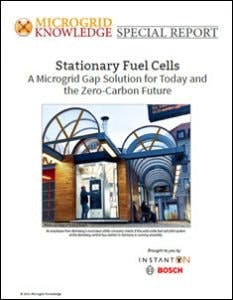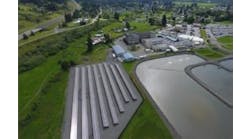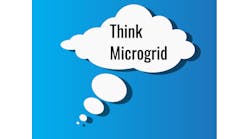In a new special report series brought to you by Microgrid Knowledge, Instant On and Robert Bosch, we explore how fuel cells can be a microgrid gap solution that fills the power gap, the fit gap and the sustainability gap. This second article explores how fuel cells fill the gaps and provide project flexibility.
Download the full report.
Utilities, businesses and homeowners are tuned in to the value of microgrids as a reliability solution. They are being deployed around the United States in all shapes, sizes and combinations, from dense urban environments to rural farms.
However, the conventional path to a new microgrid doesn’t work for everyone who needs one. Increasingly, wildfires, hurricanes, severe weather, grid infrastructure failures and public safety power shutoffs have made backup generation for critical and essential loads a necessity for many. But they can’t afford to wait the 12-24 months for a microgrid to be installed. They face a power gap.
Fuel cells are a lower carbon solution today, compared to natural gas and diesel alternatives, that ultimately can reach net-zero emissions with a no-carbon hydrogen fuel source.
In other cases, popular distributed energy resources used in typical microgrid configurations aren’t the right fit. Customers might not have the roof space or land or live in a region with enough sunlight for solar and battery storage to deliver the power required. In areas such as dense urban neighborhoods, many forms of electrification present customers with costly challenges. They face a fit gap.
Diesel-powered generators that produce excessive carbon dioxide, nitrogen oxide (NOx) and particulate matter might not fit with customers’ sustainability commitments or might run afoul of local regulations and permitting requirements. Customers might need to invest in a cleaner reliability solution now and ultimately transition to a microgrid that delivers zero-carbon energy. They face a sustainability gap.
These customers all need a Microgrid Gap Solution, and modular solid oxide fuel cells can be it. Fuel cells bridge these gaps as a quick off-grid energy solution that delivers reliability now while a long-term, grid-coupled microgrid solution is developed around it. They are a lower carbon solution today, compared to natural gas and diesel alternatives, that ultimately can reach net-zero emissions with a no-carbon hydrogen fuel source. Consider the problems of customers who need a gap solution and how fuel cells address them. (See sidebar.)
Fuel cells mean project flexibility
The ability to “fill the power gap” isn’t the only attribute that makes fuel cells the ideal Microgrid Gap Solution.
Stackable to address any level of critical or essential load from the kW to GW scale, they’re a flexible fit for projects of all sizes.
Fuel cell flexibility extends to how they work with other technologies or how they can be redeployed, if desired. When installed quickly as a gap solution, they can later be integrated into a microgrid with solar, batteries, advanced microgrid controls and most any other DER or software system to become part of the permanent, long-term microgrid solution. In fact, fuel cells can boost the value proposition of many microgrids. As a reliable, dispatchable source of on-site power serving critical and essential loads, fuel cells support and enhance the benefits of other resources within a microgrid. Fuel cells can complement intermittent DERs such as solar, battery systems and EV chargers to deliver customers better optimized outcomes for resilience, sustainability and cost management.
For more information, download the full report.
In Vårgårda, Sweden, one such integrated microgrid was installed during renovations to six public housing buildings to provide year-round renewable electricity and heat to 172 apartments from solar panels, batteries, heat pumps, hydrogen production and storage, and hydrogen fuel cells.
If maintaining fuel cells as part of the permanent microgrid is not part of the plan or a customer expects additional sites in need of a Microgrid Gap Solution down the road, fuel cells can be designed and packaged so they can be redeployed at new sites that need gap solutions after the initial job is complete.
The definitive guide to fuel cells for microgrid developers
In the coming weeks, this special report series will explore the following topics:
- How fuel cells offer a transition to — and a product for — the energy future.
- How the business model for fuel cells is a win for customers and installers.
- Opportunities for microgrid developers and other providers to grow customers and services with fuel cells.
Download the full report “Stationary Fuel Cells: A Microgrid Gap Solution for Today and the Zero-Carbon Future,” courtesy of Instant On and Robert Bosch to learn more.







